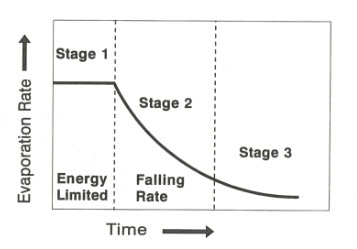Besides protecting the soil surface, crop residue can reduce evaporation, saving water for use by your crops.
Evaporation from soil occurs in three stages:
Stage 1 evaporation occurs when water is readily available at the soil surface (Steiner, 1994), as it often is under irrigation. The rate of evaporation in this stage is limited by the amount of energy arriving at the soil surface. By blocking sunlight and slowing air exchange at the soil surface, crop residue reduces the energy available for evaporation. The saved water is then available to the crop for transpiration.
In addition to the water saved by decreased evaporation, in a high residue farming system, reduced tillage and increased winter storage can also save water (Klocke, 2009). Increased winter storage is due to increased snow catch and reduced runoff. The savings from reducing tillage ranges from 0.3 – to 1″ of water per pass depending on the implement used. In some locations, total water savings from using HRF practices can be over 6″ per year:
| Source of water savings | Water savings, inches |
| Reduced evaporation | 2-3.8 |
| Elimination of tillage | 0.3-0.7 per pass |
| Increased winter storage | 1-2 |
| Total | 3.3-6.5 |
This can represent significant dollar savings for those who pump from deep wells and/or have expensive power and/or water rates.
